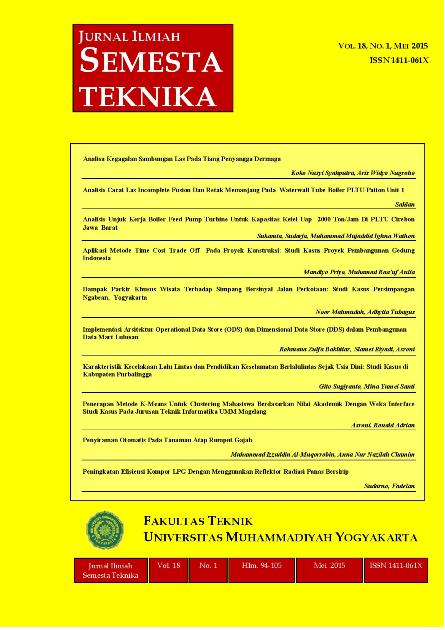Peningkatan Efisiensi Kompor LPG Dengan Menggunakan Reflektor Radiasi Panas Bersirip
DOI:
https://doi.org/10.18196/st.v18i1.710Keywords:
LPG gas stoves, finned heat radiation reflector, efficiencyAbstract
Heat wasted due to radiation from the flame around the LPG stovecan lower stove efficiency. The wasted heat would be exploited by using a finned heat reflector . The working principle of this tool is to capture the wasted heat and reflect to the load so that it becomes useful energy . Preliminary data indicate that areflector without fins can increase stove efficiency., The objective of this research isto determine the performace finned heat reflectorin increasing LPG stove efficiency. A piece of stainless steel plate as a truncated cone-shaped finned experimental model was used as a reflector. The efficiency test is done through boiling water test. The number of fin of the the same dimensions were varied, starting from one-line to three-line fins. The performance of the stoves using reflectorwith fins were compared with that of stove using reflector without finsand with that of stove without reflectot. Based on test results, it is found that the use of finned reflectors is able to increase the efficiency of LPG stoves. The highest efficiency is obtained on the use of reflectors with three rows of fins, which amounted to 44.09%. The magnitude of the increase is compared to without using a reflector at 5.22%, while compared with the reflector without fins for 5.01%. Based on the test of temperature distribution is obtained also that the use of reflector finned heat radiation can increase the area of complete combustion.Downloads
Published
2016-01-09
How to Cite
Sudarno, S., & Fadelan, F. (2016). Peningkatan Efisiensi Kompor LPG Dengan Menggunakan Reflektor Radiasi Panas Bersirip. Semesta Teknika, 18(1), 94–105. https://doi.org/10.18196/st.v18i1.710
Issue
Section
Articles
License
Semesta Teknika is licensed under a Creative Commons Attribution 4.0 International License.
Authors who publish with this journal agree to the following terms:
- Authors retain copyright and grant the journal right of first publication with the work simultaneously licensed under a Creative Commons Attribution License that allows others to share the work with an acknowledgement of the work's authorship and initial publication in this journal.
- Authors are able to enter into separate, additional contractual arrangements for the non-exclusive distribution of the journal's published version of the work (e.g., post it to an institutional repository or publish it in a book), with an acknowledgement of its initial publication in this journal.
- Authors are permitted and encouraged to post their work online (e.g., in institutional repositories or on their website) prior to and during the submission process, as it can lead to productive exchanges, as well as earlier and greater citation of published work (See The Effect of Open Access).









